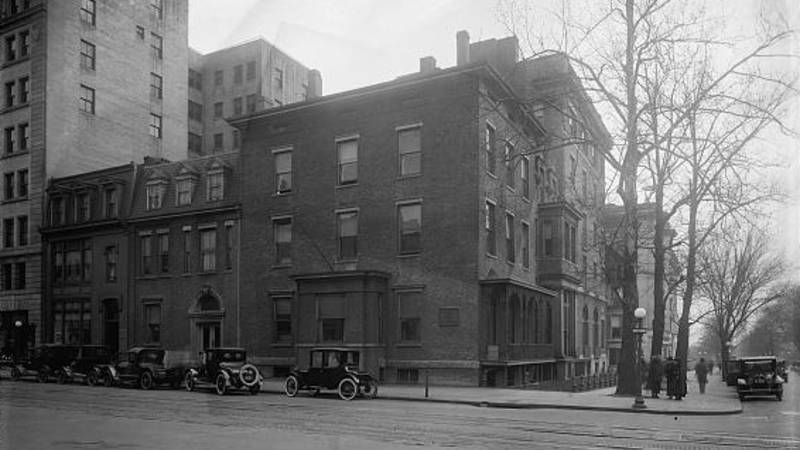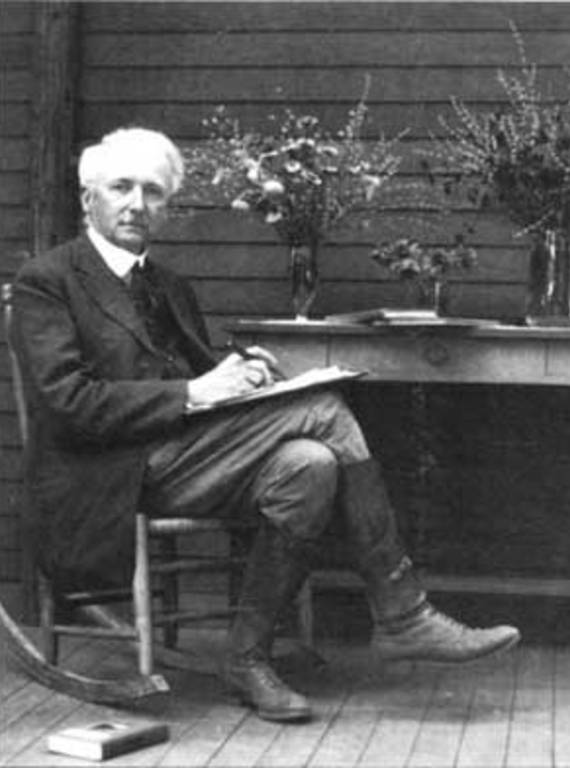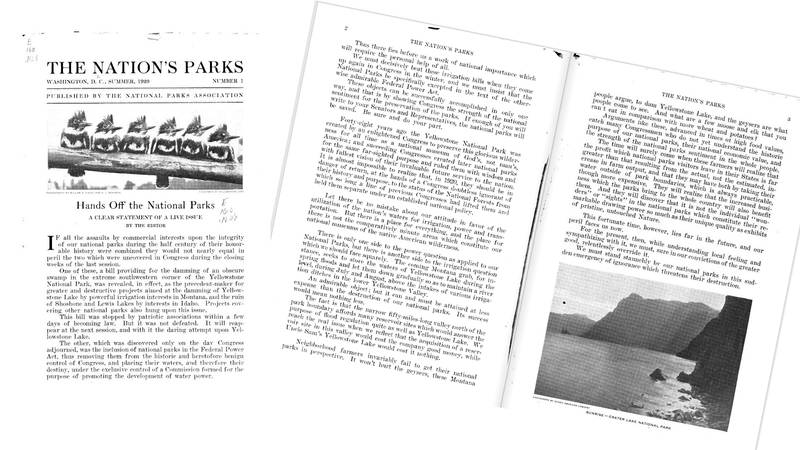
1919 was a turbulent year for the United States. But amid the chaos and discord, a hopeful, ambitious enterprise quietly commenced in the nation’s capital.

Cosmos Club, 1518 H Street, N.W., at N.E. corner of Lafayette Square
Library of Congress Prints and Photographs Division Washington, D.C.On May 19, a small group of scientists, artists and civic leaders met at the Cosmos Club, the gathering place of the day for those who had distinguished themselves in the arts and sciences, academia and public service.
The assembly, all members of the National Parks Educational Committee, was notable. Sculptor Henry Kirke Bush-Brown was the creator of three equestrian bronzes that still stand at Gettysburg National Military Park. William Henry Holmes, the namesake of Yellowstone’s Mount Holmes, was a noted archaeologist who would become director of the National Gallery of Art. Anthropologist Jesse Walter Fewkes had led excavations of Casa Grande and Mesa Verde and called for legislation to stem the vandalism of ancient sites in the Southwest. Attorney Henry Brown Floyd McFarland was a onetime newspaper reporter and president of the Washington, D.C. Board of Commissioners. Paleontologist Charles Doolittle Wolcott was the administrator of the Smithsonian Institution and previously had served as director of the U.S. Geological Survey.

Robert Sterling Yard
NPCALed by committee founder Robert Sterling Yard, an inveterate writer turned promoter of the national parks, the six men signed the articles of incorporation forming a new organization with a mission to educate the American public about the nation’s parks and to inspire them to experience and protect them. The National Parks Association — known today as the National Parks Conservation Association — was born.
NPA’s founding was the culmination of the vision Yard shared with his longtime friend, the industrialist Stephen Tyng Mather: the creation of both an agency to unify and manage the nation’s growing number of parks and an independent organization of informed citizens to be their voice.
Four years earlier, the two men — each of them blessed with boundless energy — spearheaded the movement to establish both bodies. Mather, who had made his personal fortune in the borax industry, was serving as Assistant to the Secretary of the Interior, tasked with building support for the creation of a National Park Service. To help promote the idea, he hired Yard, with whom he had forged a fast friendship during their days as young newspapermen in New York City — even paying Yard’s salary out of his own pocket.
Together, Mather’s conviction and charisma and Yard’s impassioned writing would prove to be persuasive.
In the summer of 1915, they hosted what became known as the Mather Mountain Party, bringing together more than a dozen elected officials, captains of industry and men of arts and letters for 12 days in the splendor of Sequoia National Park and the surrounding peaks and valleys. They hiked among massive redwoods, camped beneath the stars, and enjoyed sumptuous feasts prepared in the backcountry by camp cook Tie Sing. In the cathedrals of the Sierra Nevada, Mather won influential converts to his cause.
By the following summer the campaign for a National Park Service reached a nationwide audience, anchored by the June 1916 publication of Yard’s book “National Parks Portfolio,” which portrayed the wonders of these places through striking photography and effusive prose. Effectively, it introduced the parks to the decisionmakers of a nation that “possesses an empire of grandeur and beauty which it has scarcely heard of,” as Mather wrote in the book’s preface. “In its national parks it has neglected, because it has quite overlooked, an economic asset of incalculable value.” More than a quarter-million copies were distributed — including one to every member of Congress. By the summer’s end, the campaign had succeeded. On August 25th, President Woodrow Wilson signed the Organic Act of 1916, establishing the National Park Service.
Mather and Yard each would assume positions in the new agency — Mather became its first director and Yard its chief of education — but remained committed to the establishment of an independent organization devoted to educating the American people and moving them to protect their national parks. “The big fruits of the national parks movement,” Yard wrote in 1918, “which … has its roots in the heart and mind of every American, can … be cultivated only by an organization of the people outside of government, and unhampered by politics and routine.”
Plans were delayed by the nation’s entry into World War I but finally came to fruition in the spring of 1919, when Mather announced Yard’s departure from the Park Service to take the helm of a nascent National Parks Association:
Mr. Robert Sterling Yard, who has been so long connected with the Department as editor on national park matters, has resigned to become executive secretary of the National Parks Association. … It is expected that the relations between the National Parks Association and the Service will be very intimate and cordial. Mr. Yard is splendidly equipped for his new duties by his deep interest in all national park affairs and his wide knowledge of the subject.
Yard needed to be so equipped, for he would be the organization’s sole staff member for nearly a quarter-century, recruiting members, issuing news bulletins, working with the board of trustees and advancing NPA’s positions on matters related to the creation and protection of a growing number of parks. Within months, NPA addressed its first issue — protecting Yellowstone’s starving elk from being slaughtered by hunters upon crossing park boundaries in search of forage — and in 1921 marked its first successful park defense by opposing and defeating a proposed dam on the Yellowstone River near the outlet of Yellowstone Lake.
The organization attracted to its board of trustees such luminaries as naturalist Olaus Murie, wildlife activist Bob Marshall and landscape architect Frederick Law Olmsted, Jr., who had contributed pivotal language to the legislation creating the Park Service. Presiding over the board were such notable figures as George Bird Grinnell, who previously had founded the forerunner of the National Audubon Society — and even a future president of the United States, Herbert Hoover.
That influence allowed NPA to form a coalition of park proponents and pressure Congress to pass the Everglades Act in 1934, paving the way for the eventual designation of Everglades National Park. But NPA’s purist views of what a park should be — in a word, primeval — put it out of step, at times, with the rest of the conservation community, as when it opposed the designation of parks such as Shenandoah and Kings Canyon for not meeting that standard. Purism also led to division within the organization itself. The expansion of the park system during the Depression laid bare internal tensions over selection standards, prompting Robert Sterling Yard and trustee Bob Marshall to channel their idealism into the creation of The Wilderness Society. Yard resigned as executive secretary in 1933 — a financially strained NPA could no longer pay his salary — but, loyal to the cause, remained the organization’s publications editor on a volunteer basis until 1942 and led the newly-minted Wilderness Society until his death in 1945 at the age of 84.
Yard’s successor was Devereux Butcher, a writer, photographer and conservationist who redoubled NPA’s efforts to educate and inspire park supporters by launching National Parks magazine. The publication was instrumental in not only rebuilding a membership depleted during the Depression but also articulating the organization’s positions on an increasingly complex set of issues. When wartime timber production threatened old-growth forests in Olympic National Park in Washington, a pointed editorial in the magazine helped tip the balance toward their protection. And by the time conservationists rallied against proposed dams affecting Dinosaur National Monument in the 1950s and Grand Canyon National Park in the 1960s, NPA had a well-established one-two punch: education and outreach through its flagship publication coupled with effective lobbying, testimony and advocacy in the corridors of power.
Then came the 1970s, ushering in the first Earth Day, the Clean Air Act and the Clean Water Act. The environmental movement was on the rise and in response, Anthony Wayne Smith, who had succeeded Butcher in 1959 and initially led NPA through some fruitful years, steered the organization into unfamiliar and often contentious waters — immigration and population policy were among his pet issues — that caused the organization to lose focus, influence and members. Smith’s troubled tenure barely survived the decade but one significant change stuck: NPA had become the National Parks and Conservation Association. (The conjunction, part of the 1970 name change, later became an ampersand before being dropped altogether in the early 2000s.)
When Paul Pritchard became executive director in 1980, NPCA renewed its focus on its core mission of park protection. It launched its first regional program and marked the passage of the Alaska National Interest Lands Conservation Act, which doubled the acreage of the park system. Other victories soon followed, including a legal ruling that kept nearly all national parks off-limits to hunting and the establishment of new sites such as Great Basin National Park in Nevada and Tallgrass Prairie National Preserve in Kansas. That momentum carried into the new millennium with Tom Kiernan at the helm, as NPCA secured a record Park Service funding increase, published comprehensive reports on the state of the parks, convened the National Parks Second Century Commission, and hosted a series of Mosaic in Motion conferences to make stronger connections between the park system and communities of color.
In the decade leading up to its centennial, NPCA mounted a string of victories that would have made Yard and Mather proud, protecting iconic places — from Glacier and Gettysburg to Great Smoky Mountains and Grand Canyon — from mining, landfills, coal-fired power plants and all manner of inappropriate development that threatened park air, water and wildlife. It also affirmed its founding principles while working to create a park system more accessible and relevant to all Americans. Led for the first time in its history by a female chief executive, Theresa Pierno, the organization advocated tirelessly for new park sites — such as Pullman, Stonewall, and Belmont-Paul Women’s Equality National Monuments — that helped to tell and enshrine a more complete American story.
NPCA’s work is far from finished — and likely never will be. In fact, the need for the organization Robert Sterling Yard called “the fearless and outspoken defender of the people’s parks and the wild life within them against the constant, and just now the very dangerous, assaults of commercial interests” has never been greater.

The first three pages of The Nation’s Parks
Now More Than Ever
In 1920, Robert Sterling Yard published The Nation’s Parks, a richly illustrated 16-page pamphlet that was in many ways the precursor of National Parks Magazine. It was, as Yard wrote, “issued by an association of citizens which seeks the finest possible upbuilding of a system destined to become one of our most valuable economic assets, and to promote the widest possible uses of the parks by all the people.”
In its pages, he captured with remarkable foresight not only the imperative that led to the organization’s founding but the destiny it would fulfill:
The Association’s work does not overlap that of the Department of the Interior; it begins where the Governmental function ceases, for Congress provides only for the physical development of our National Parks. Their enormous value to popular education, to the increased pleasure which comes only with understanding, to outdoor living and to travel in America is left for the people to develop. It is to help reap this important harvest and to bring together in a common endeavor the helpful citizens of every part of the land that the National Parks Association was founded.
Its opportunity, however, is much greater, and the Association is availing of this to the full. Unconnected with the Government and absolutely independent of political or other adverse influences, it has become the fearless and outspoken defender of the people’s parks and the wild life within them against the constant, and just now the very dangerous, assaults of commercial interests.
To read those words in the context of the current day and to appreciate their relevance so long after Yard first penned them is confirmation of the clarity of the vision that founded the National Parks Conservation Association — and reassurance that it will continue to bring Americans from all walks of life together to fight the good fight for the century ahead.
Make a tax-deductible gift today to provide a brighter future for our national parks and the millions of Americans who enjoy them.
Donate Now
